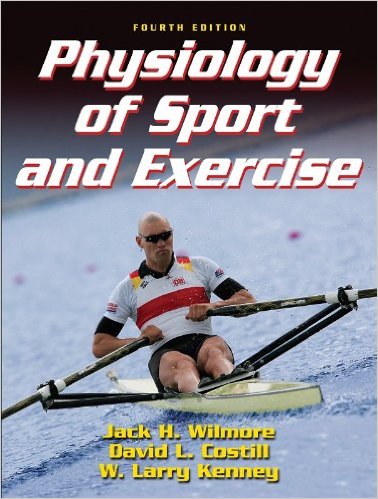Today’s session
Strength training today, preceded just by a prolonged warming up on the erg (3km at very easy pace).
The same set as last week.
- Pull ups – 10/9/7
- Pistol Squats with a dumbbell – 15/15/15
- Dorsal raise on Gym Ball – 15/15/15
- Squats – purple bodylastics band – 15/15/15
- Crunches & twist with dumbbell 10/10/10
- Squatted row with orange bodylastics band – 15/15/15
- Lunges with dumbbell – 15/15/15
- Breast press with black bodylastics band – 15/15/15
The bold is where I went up a notch in terms of resistance. I need to find a way to increase the resistance on the leg exercises. I’d like to work in a 10-15 rep range, lowering the resistance if I can’t do 3×10, increasing it if 3×15 is achieved easily.
I feel I am nearing the end of the first “block” of strength training and need to start defining the second block.
Some play with numbers

All the lactate measuring has stimulated me to reread a physiology book I own. In chapter 2, “fuel for exercising muscle”, I found an interesting figure that indicated the “typical” maximal rate of ATP generation (in mmol ATP/kg dry mass/s) for the different energy pathways, as well as the maximal available energy.
Assuming 7.3 kJ/mol that can be released from ATP, of which 60% goes to heat directly, and assuming a mechanical efficiency of 25%, a 72kg LW man should be able to produce 630W for about a minute. (I am ignoring the PCr pathway.) Assuming that on shorter rows (<500om) the average power from glycolysis is determined by the maximum available energy through glycolysis, I am able to make a crude approximation for the power and pace dependence on distance rowed.
The blue dots are the Nonathlon target pace/power for my age and weight group. The black line is my prediction.
I am amazed that this crude calculation even ends up in the right ballpark. Sometimes calculating things seems to work. My calculation also gave as a result that during a 2k, roughly 85% of the power comes from aerobic energy pathways.
Of course a couple of things are wrong. First, the nonathlon values are an average over age group records. They don’t represent one typical rower. We all know that there are sprinters and steady state rowers. Second, I have no model for the decline of the power from Aerobic processes as the distance increases, so my prediction. is too fast for any distance above 10k. It is also interesting that the 2k is faster on nonathlon. Could this be because the 2k is the standard distance? Finally, the balance of the different pathways as a function of power is individual and much more complex than my crude model.
Follow me in social media
Like this:
Like Loading...
Nov 27 2015
Strength & innocent number play
Today’s session
Strength training today, preceded just by a prolonged warming up on the erg (3km at very easy pace).
The same set as last week.
The bold is where I went up a notch in terms of resistance. I need to find a way to increase the resistance on the leg exercises. I’d like to work in a 10-15 rep range, lowering the resistance if I can’t do 3×10, increasing it if 3×15 is achieved easily.
I feel I am nearing the end of the first “block” of strength training and need to start defining the second block.
Some play with numbers
All the lactate measuring has stimulated me to reread a physiology book I own. In chapter 2, “fuel for exercising muscle”, I found an interesting figure that indicated the “typical” maximal rate of ATP generation (in mmol ATP/kg dry mass/s) for the different energy pathways, as well as the maximal available energy.
Assuming 7.3 kJ/mol that can be released from ATP, of which 60% goes to heat directly, and assuming a mechanical efficiency of 25%, a 72kg LW man should be able to produce 630W for about a minute. (I am ignoring the PCr pathway.) Assuming that on shorter rows (<500om) the average power from glycolysis is determined by the maximum available energy through glycolysis, I am able to make a crude approximation for the power and pace dependence on distance rowed.
The blue dots are the Nonathlon target pace/power for my age and weight group. The black line is my prediction.
I am amazed that this crude calculation even ends up in the right ballpark. Sometimes calculating things seems to work. My calculation also gave as a result that during a 2k, roughly 85% of the power comes from aerobic energy pathways.
Of course a couple of things are wrong. First, the nonathlon values are an average over age group records. They don’t represent one typical rower. We all know that there are sprinters and steady state rowers. Second, I have no model for the decline of the power from Aerobic processes as the distance increases, so my prediction. is too fast for any distance above 10k. It is also interesting that the 2k is faster on nonathlon. Could this be because the 2k is the standard distance? Finally, the balance of the different pathways as a function of power is individual and much more complex than my crude model.
Follow me in social mediaShare this:
Like this:
By sanderroosendaal • Uncategorized • 2 • Tags: rowing, strength, training